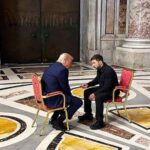Trust is an important ingredient in our daily lives. We trust the advice of total strangers online when making decisions about restaurants and hotels. We trust the opinions of social media influencers. We trust that the brands we use will do what they say they will do. As trust in institutions, experts and leaders declines, brands have an enormous opportunity to become the most trust-powered sources of relevant and differentiated promises.
The more trusted a brand is, the more Trust Capital it generates, the more powerful that brand is to weather a crisis. The more trusted a brand is, the more customers will rely on it to satisfy their needs and address their problems.
This article is part of Branding Strategy Insider’s newsletter. You can sign up here to get thought pieces like this sent to your inbox.
As a form of organizational wealth, Trust Capital is the confidence stakeholders have in the goodwill of an organization to consistently deliver promises of value. Trust Capital leads to high quality revenue growth. Trust Capital is an intangible asset that increases the power of marketing expenditures, and reduces the cost of new brand introductions. It helps attract and retain quality employees. Trust Capital is a valuable asset during times when a brand needs to defend itself in unexpected, difficult situations.
Trust is earned. Trust takes time to build. Yet, trust can be lost in an instant. Trust requires openness, transparency, honesty and standing up for what you stand for. Trust building requires enterprise-wide action.
Brands need to think of themselves as sustainable power plants, continuously, and responsibly generating Trust Power.
Some of our biggest, most trusted brands such as Boeing, Starbucks and McDonald’s are experiencing trust deficits, all of which are self-inflicted. Boeing’s trust deficit comes from several years-worth of safety issues that have included large-scale tragedies. Starbucks’ trust deficit comes from years of poor delivery, out-of-stocks and the fading of its brand promise and core essence. McDonald’s trust deficit comes from its recent E. Coli incident (where there was one death), its pricing-out of its core customer base, its apparent belief that price and value are the same and, therefore, its subsequent loss of value in the customers’ eyes.
Trust Power comes from having 1) high Trustworthy Brand Value, 2) having a large and growing reservoir of Trust Capital, 3) consistent, growing high quality revenue growth, leading to 4) enduring profitable growth.
There are many definitions of trust. Trust is defined as “the expectation held by the consumer that the service provider is dependable and can be relied on to deliver on its promises.” Some define trust as “a willingness to rely on an exchange partner in whom one has confidence.” For trust to develop, there must be an ability to consistently deliver against expectations.
Trust is fundamental in building and maintaining long-term relationships: personal and brand-business. It enhances the quality of a relationship and minimizes perceived risk.
Customer perceived value is the customer’s overall assessment of the usefulness of a product (or service) based on perceptions of what is received and what is given”. Customer perceived value is the fundamental basis for all marketing activity.
A brand’s total brand experience is inexorably tied up with the customer’s perception of the brand’s Trustworthy Brand Value. Customers today assess a brand’s worth based on the total brand experience (functional benefits, emotional and social rewards) relative to the total experience costs (money, time and effort.) And, customers have also a very important component in their value equation. Trust is a value multiplier. When customers assess a brand’s value, they think about how much they trust the brand: trust is the consumer’s belief that the brand will deliver the brand’s total experience relative to the total costs. How confident am I that this brand will deliver the promised experience for the expected costs? The new mental model of value is total brand experience relative to total experience costs all multiplied by trust: the Trustworthy Brand Value™ equation.
If trust in the brand is high, then as a multiplier, the perceived brand value is increased. If trust in the brand is low, then the perceived brand value is decreased. If there is no trust in the brand, if trust in the brand is zero, then it does not matter what the promised brand experience is relative to the costs: anything multiplied by zero is zero. Expertise will not matter if there is no trust.
Having high Trustworthy Brand Value, helps to produce Trust Capital. Trust Capital grows when organizations consistently deliver promises of value and responsibility.
Trust Power generates from the symbiotic relationship between high Trustworthy Brand Value and an increasing reservoir of Trust Capital. High Trustworthy Brand Value reduces uncertainty, builds brand preference, which increases brand loyalty. Increased brand loyalty means stronger customer-brand bonds, more willingness to rely on the brand, stronger beliefs that the brand is a reliable, responsible partner. Increased brand loyalty reduces price sensitivity, and increases marketing productivity. As risk reduces, as preference augments, as loyalty cements, Trust Capital grows. This growth in Trust Capital leads to high quality revenue growth, resulting in enduring profitable growth.
Brands with high Trustworthy Brand Value, growing funds of Trust Capital, increased quality revenue growth, leading to enduring profitable growth have Trust Power.
Accelerate Your Job Search With Marketing’s Most Advanced AI Career Coach
Aim For Trust Power
Here are some actions for building Trust Power. Boeing, Starbucks and McDonald’s should perhaps take note of these as it appears as if their Trust Power generators on low on fuel.
1. You Are What You Do
Trust must be displayed before it can be declared. Customers must consider your brand worthy of trust before they commit to trusting your brand. Saying “trust me” does not track with today’s customers. Provide iconic, tangible evidence that what you are claiming can be trusted. Iconic products or services are tangible demonstrations of the truth of your claim.
Starbucks promised a third place, a place away from home or office, a convenient café experience where you could relax alone or sit with friends, savoring a variety of great tasting, personalized, freshly prepared coffees while “drinking” in great coffee aromas. Over time, this café experience eroded. Current CEO, Brian Niccol articulate the need to return to Starbucks core promise. In the past few weeks, Mr. Niccol has re-instated iconic services to show the brand’s intention to deliver.
Boeing is hoping the terms of its just-agreed contract with union members will begin to rebuild trust with workers. According to New York Times reporting, workers had lost faith in Boeing management. There were frustration and anger due to past labor negotiations. When it comes to quality, there is more than just product quality; there is relationship quality which requires trust.
2. Be A Trustworthy Source Of Information
The author Joseph Conrad said the power of sound has always been greater than the power of sense. Trusted messages must come from a trustworthy source. Customers must feel confident enough to make decisions supported by reliable information.
Providing trustworthy information is critical. The challenge is to become a trustworthy source of information that is helpful, convenient, understandable and valuable to your customers.
McDonald’s CEO, Chris Kempczinski, apologized to shareholders and analysts in the latest McDonald’s earnings call. Mr. Kempczinski said that he was sorry people became ill at McDonald’s. Most customers do not listen to earnings calls. Most customer do not read earning call transcripts. Hopefully, Mr. Kempczinski apologized to employees and customers. It is offensive to put shareholders above customers and employees. Without the trust of customers and employees, there is no brand value. And, no brand value means no shareholder value.
3. Be Open And Transparent
Openness is an opportunity. Truth is not the same as trust. Truth is a fact. Trust is a feeling. Brands need both truth and trust. To be worthy of a customer’s trust, people need to see the truth not just read about truth. Over 20 years ago, a study of business leaders concluded that “Without openness, trust is blind.”
Starbucks is “showing” customers that the brand is working to address their concerns. Returning the condiment bar and writing your name on the cup may seem like small actions. But, these are tangible actions, visible actions that what the brand is saying is the truth. McDonald’s once had a food quality issue in France. The brand addressed the issue by literally “opening doors” to the kitchen. Teachers, parents and children were able to see how McDonald’s assembled and prepared its foods, how grills were cleaned, how floors were mopped.
4. Have A Trust Agenda
Brands must generate and implement a Trust Agenda. A Trust Agenda is essential for nurturing and growing trust. A Trust Agenda is a common, corporate codification of behaviors reflecting how the brand will focus and lead on responsibility, credibility and integrity. A Trust Agenda is designed to generate “good growth.” Good results and good behaviors are the winning combination. Having a Trust Agenda helps configure trust into the organization and into its brands.
Although Boeing’s problems derive from issues other than branding, the Boeing brand is in terrible shape. The New York Times wrote that Boeing may have settled its contract disputes but still faces a number of serious problems. Improving quality, making more jets, business stabilization such as stopping the bleeding and catching up with its competitor Airbus were listed as must-do now actions.
Having a Trust Agenda would not only address the specific issues of safety and quality, but would address ways in which Boeing can begin to engender trust among all its stakeholders. In 1999, Nissan’s new management recognized that although quality manufacturing had deteriorated, the Nissan brand was now perceived to be a lesser brand than Toyota. A Nissan branded vehicle would require an incentive of over US$1000 for a customer to consider a purchase. Brand became an integral part of the agenda for rebuilding trust. Boeing should be making the connection between its manufacturing issues and trust in the Boeing brand.
Boeing, Starbucks and McDonald’s should create and activate Trust Agendas.
5. Measure Trustworthy Brand Value
Trustworthy Brand Value is customer-perceived brand value multiplied by trustworthiness. Trustworthy Brand Value is what the brand stands for – its total brand experience – relative to the brands costs – money, effort and time – and the level of trust customers place in the brand to deliver its experience relative to its costs.
Do not believe that brand satisfaction is the more important metric. Brand satisfaction is important, but it is not sufficient. Satisfaction is an indicator of perceived brand performance relative to competition: satisfaction is relative. Overall satisfaction is a precursor of brand trust but it is not a surrogate for trust. Common sense dictates that customers will probably not trust brands that deliver an experience that is not satisfactory. There is no loyalty without trust. There are buckets of data to show that although satisfaction influences purchase intention, it does not directly affect repurchase behaviors, whereas customer-perceived value positively influences brand loyalty.
Brand trust is an acknowledgment of brand motivation. Brand trust is the potent, commanding idea that a brand has its customers’ best interests in mind and that the brand will do whatever it takes to consistently deliver on its promise. Brand trust is a feeling of security that a brand will meet your consumption expectations. Brand trust affects customer commitment that, in turn, influences price tolerance.
Importantly, you cannot have trustworthy brand value without brand trust. Trustworthy brand value generates both true brand loyalty and a strong corporate brand. These elements generate high quality revenue growth leading to enduring profitable growth. This is trust power: more customers, who purchase more often, who are more loyal, providing more revenue and more profit.
Contributed to Branding Strategy Insider by: Joan Kiddon, Partner, The Blake Project, Author of The Paradox Planet: Creating Brand Experiences For The Age Of I
At The Blake Project, we help clients worldwide, in all stages of development, define and articulate what makes them competitive and valuable. Please email us to learn how we can help you compete differently.
Branding Strategy Insider is a service of The Blake Project: A strategic brand consultancy specializing in Brand Research, Brand Strategy, Brand Growth and Brand Education
Post Views: 0










